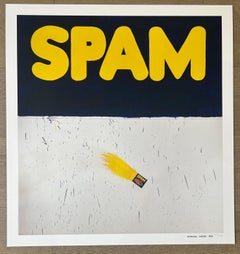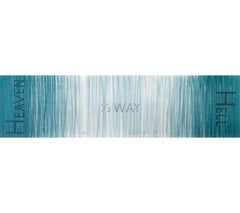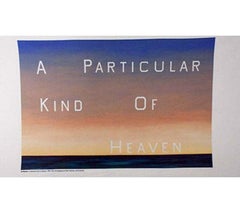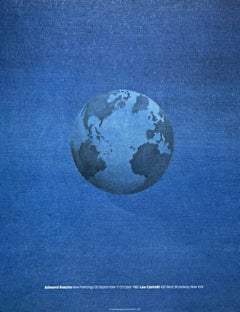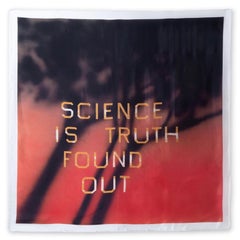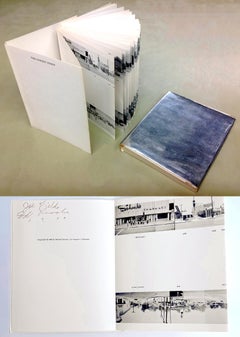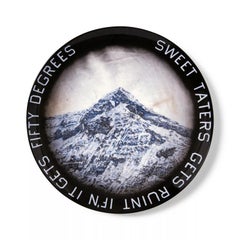Ed Ruscha
Indisputably one of the most iconic American artists of the 20th century, Ed Ruscha has built a formidable body of work by staking a claim on the deceptively simple intersection of text and image, superimposing elliptical phrases (or, often, single words) over West Coast landscapes to create prints and paintings that can be read instantaneously yet evade easy understanding.
Alongside artists like Robert Irwin and Billy Al Bengston, Ruscha was a pioneer of the 1960s Los Angeles art scene as part of the famed Ferus Gallery. His embrace of Hollywood vernacular and the open Western road have tied him as closely to the identity of L.A. art as Jackson Pollock is to that of New York.
Coming to California in 1956 at the age of 18, Ruscha intended to become a commercial painter but found himself drawn to fine art, over time being shaped by three galvanizing influences: Marcel Duchamp, Pop art and the movies.
Meeting Duchamp when the Pasadena Art Museum (now the Norton Simon Museum) hosted the French Conceptual artist's first U.S. show, Ruscha was especially affected by his use of "readymade" objects and imagery, rendered unfamiliar through unexpected titles or text. Andy Warhol's Campbell's Soup can paintings, meanwhile, were shown for the first time at the Ferus Gallery in 1962, opening up new vistas for Ruscha. Movies, then, provided another inspiration through their use of title cards, placing graphic text over filmic shots — The End, for instance — for maximum impact.
Ruscha began his famous series of word paintings in the 1960s, depicting various views of the Hollywood sign and the logos of studios like 20th Century Fox, but also roadside views like the Standard Oil stations dotting L.A.'s freeways. Over time these became more abstracted, pinning ambiguous, free-floating phrases (Wall Rockets is a famous example) to natural vistas, scenes of highways, or monochrome backgrounds. Beginning in about 1980, the artist began using a sharp font he designed himself, called Boy Scout Utility Modern.
A master printmaker who also works across the mediums of books, drawing, photography and even film — in 2009 he starred in a movie directed by the artist Doug Aitken — Ruscha has been an influence on a staggering array of artists, including Stephen Shore, Christopher Wool and Anselm Kiefer.
Ruscha's work has been featured in dozens of exhibitions around the world, including "Ed Ruscha: 50 Years of Painting" at London's Hayward Gallery (2009), "Ed Ruscha: Made in Los Angeles" at Madrid's Reina Sofia in 2002, a 2000 retrospective at the Hirshhorn Museum and Sculpture Garden, a survey of his works-on-paper at the J. Paul Getty Museum in 1998, and a 1982 retrospective that traveled to the Whitney Museum. In 2005 he represented the United States at the 51st Venice Biennale, and in 2009 he received a National Arts Award.
Find a collection of original Ed Ruscha lithographs and other art for sale on 1stDibs.
| Average Sold Price |
| $1,529 |
| Styles |
| Materials |
| Related Artists |
2010s Contemporary Ed Ruscha
Pigment, Screen
1980s Contemporary Ed Ruscha
Paper
1980s Contemporary Ed Ruscha
Aquatint
21st Century and Contemporary Contemporary Ed Ruscha
Cotton
1980s Pop Art Ed Ruscha
Offset, Lithograph
2010s Pop Art Ed Ruscha
Cotton, Silk, Mixed Media, Screen
1960s Pop Art Ed Ruscha
Foil
2010s Contemporary Ed Ruscha
Ceramic
Ed Ruscha Sale Prices
| Sold Date | Sold Price | Category | Medium | Creation Year | ||||||||||||||||||||||||||||||||||||||||||||||
|
| $1,529 |
Average sold price of items in the past 12 months |
| $300-$7,200 |
| Sold price range of items in the past 12 months |
Artists Similar to Ed Ruscha
Ed Ruscha art for sale on 1stDibs.
- Why is Ed Ruscha important?1 Answer1stDibs ExpertApril 5, 2022Ed Ruscha is a multi-medium contemporary artist who has widely been hailed as an important player in the Pop Art movement. You can shop a selection of Ed Ruscha’s pieces from some of the world’s top art dealers on 1stDibs
- What is Ed Ruscha famous for?1 Answer1stDibs ExpertApril 5, 2022Ed Ruscha is famous for his text paintings made during the 1960s. The American conceptual and Pop art artist was born on December 16, 1937, in Omaha, Nebraska. On 1stDibs, you can shop a collection of Ed Ruscha textual art.
- What is Ed Ruscha's art style?1 Answer1stDibs ExpertFebruary 27, 2024Ed Ruscha's art style is Pop art. He is especially well known for elevating words and signage into works of art. Ruscha began his famous series of word paintings in the 1960s, depicting various views of the Hollywood sign and the logos of studios like 20th Century Fox, but also roadside views like the Standard Oil stations dotting L.A.'s freeways. Over time, these became more abstract, with ambiguous, free-floating phrases pinned to natural vistas, scenes of highways and monochrome backgrounds. Shop a variety of Ed Ruscha art on 1stDibs.
- 1stDibs ExpertMay 14, 2024The Sand in the Vaseline from Ed Ruscha is the name of a work of art. Ruscha produced the piece by painting the words "sand in the vaseline" in egg yolk on gray satin. His goal in producing the painting was to evoke feelings of confusion in the viewer. When asked about his motives, he responded, "Isn't disorientation one of the best things about making art?" Find a range of Ed Ruscha art on 1stDibs.
- How did Ed Ruscha make his art?1 Answer1stDibs ExpertApril 5, 2022Ed Ruscha made his well-known collage art by combining words and images from advertisements and other pieces of media. He often incorporated found items and unconventional materials like blood, liquid medicine and food. You'll find a selection of Ed Ruscha art on 1stDibs.
- 1stDibs ExpertMarch 22, 2022Yes, Ed Ruscha is a conceptual artist. His work also shows elements of Pop art. However, the artist does not associate his own work with either movement. He is well known for his text paintings first produced during the 1960s. Find a variety of Ed Ruscha on 1stDibs.
